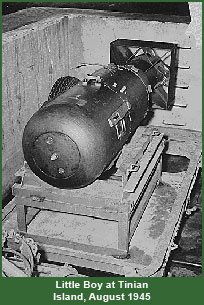
Time Periods
1890s-1939:
Atomic Discoveries
1939-1942:
Early
Government Support
1942-1944:
The Uranium
Path to
the Bomb
1942-1944:
The Plutonium
Path to
the Bomb
|
With the end of the Second World War, American policymakers anticipated that the Manhattan Project's infrastructure would be turned over to and managed by a largely civilian commission. General Leslie Groves initially thought this would happen soon after the ending of hostilities. His strategy for interim management of the complex was thus one of "hold the line," where he sought to maintain the essential soundness of the physical plant and the personnel that ran it, complete ongoing construction, and promote efficiency and economy. One of his first decisions was to close down marginal operations such as the S-50 Thermal Diffusion Plant in the K-25 area and the Alpha racetracks of the Y-12 electromagnetic separations plant at Oak Ridge. His most serious short-term problem was in retaining personnel, particularly at Los Alamos where many scientists and technicians were eager to return to civilian pursuits. By early 1946, Groves realized that the Manhattan Engineer District's trusteeship of the complex might last for an extended period of time. He decided to abandon the hold-the-line policy and begin making longer range plans for the complex, even though this might restrict the freedom of action for any future commission. Expiring operating contracts at major sites demanded his immediate attention. He negotiated extensions through mid-1947 for all of the contracts except for at Hanford, where the DuPont Corporation was determined to withdraw. Groves turned to the General Electric Company, which agreed to replace DuPont. As part of the new contract to operate Hanford, General Electric would also construct and operate a government-owned laboratory at Knolls, a site five miles from the company's home plant at Schenectady, New York. The laboratory would allow General Electric to pursue the development of atomic power.
Groves also attempted to prevent the disintegration of the nationwide nuclear research organization that had been built up during the war. Upon the advice of the Advisory Committee on Research and Development that he set up, Groves initiated the national laboratories system that would conduct unclassified fundamental research requiring equipment too expensive for the academic or private sector laboratories to afford. In April 1946, the University of Chicago agreed to operate the new Argonne National Laboratory formed from the existing Metallurgical and Argonne laboratories. In July, nine northeastern universities banded together to operate the Brookhaven National Laboratory located at an old Army camp on Long Island, New York.
Despite Groves's best efforts, the Manhattan Project complex suffered in the aftermath of the war. By early 1947, the nation's atomic energy establishment amounted to little more than the remnants of the military organization and facilities that had produced the world's first atomic weapons.
Sources and notes for this page.
The text for this page was adapted in part from, and
portions were taken directly from the
Office of History and Heritage Resources
publications:
F. G. Gosling,
The Manhattan Project: Making the Atomic Bomb
(DOE/MA-0001; Washington: History Division, Department
of Energy, January 1999), 55; and Richard G. Hewlett and Oscar E. Anderson,
Jr., The New World, 1939-1946: Volume I,
A History of the United States
Atomic Energy Commission
(Washington: U.S. Atomic Energy Commission, 1972),
301-302, 624-637, 646, and Hewlett and Francis Duncan,
Atomic Shield, 1947-1952, Volume II,
A History of the United States Atomic Energy
Commission
(University Park, PA: Pennsylvania State University
Press, 1969), p. xiii.
Home |
History Office
|
OpenNet
|
DOE
|
Privacy and Security Notices |




